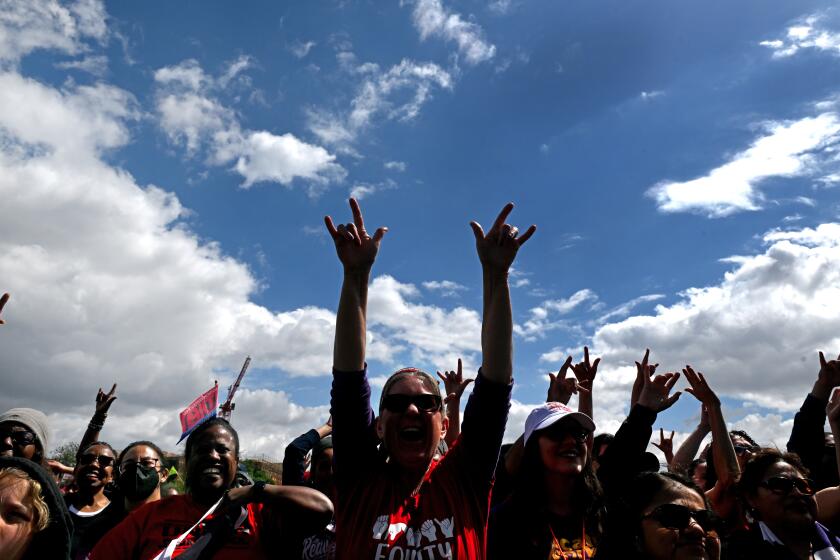L.A. County homeless services workers can’t afford housing themselves, study finds

- Share via
Front line workers essential to solving Los Angeles County’s homelessness crisis do not make enough money to afford housing themselves, leading to burnout and high turnover, a new report has found.
Researchers with Rand Corp., the nonpartisan think tank that published the report on Wednesday, estimate that the workers need to make $64,000 annually to afford a one-bedroom apartment, or $82,000 for a two-bedroom.
Instead, they make about $40,000 to $60,000, spending a large portion of their income on rent, with little money left for other necessities.
According to the study, the low pay places financial, emotional and health burdens on workers already facing hazardous and stressful conditions. They eventually leave for other careers, creating staffing shortages that ultimately affect the quality of care given to people experiencing homelessness.
The report focuses mostly on homeless services workers at nonprofits, who perform a broad range of jobs from case management to outreach, helping to connect people experiencing homelessness with housing and health services as well as food assistance and job training.
In L.A. County, high rents and other cost of living increases have fueled demands for better wages across industries, including at the Los Angeles Unified School District, where custodians, teachers aides and others went on strike for three days before winning raises of about 30% or more for the lowest paid workers.
The agreement comes after L.A. Mayor Karen Bass intervened to mediate the protracted dispute that led to a three-day strike and LAUSD school closures.
A year ago, Heidi Marston, the chief executive of Los Angeles Homeless Services Authority, resigned after giving raises to her lowest-paid staffers without approval from the commission that oversees the agency.
In her resignation letter, Marston said that LAHSA employees were making as little as $33,000, leading to high turnover. In March 2021, she increased the annual salaries of 196 employees to $50,000 while freezing the compensation of the 10 highest-paid staffers.
Va Lecia Adams Kellum, the new head of LAHSA, makes $430,000 a year, according to LAHSA documents.
Heidi Marston tendered her resignation over a disagreement with the organization’s board about the salaries of its lowest-paid staffers.
In a written statement, Kellum said the report confirms that inadequate compensation for staffers will lead to worse outcomes for unhoused people. She said LAHSA is working with federal, state and local partners to develop more flexible funding models that will allow for higher pay.
“This is lifesaving work, and we must ensure that staff who are out every day working to solve homelessness can earn a fair living,” she said in the statement.
Christine Margiotta, executive director of the nonprofit Social Justice Partners LA, which commissioned the study, said the low wages disproportionately affect Black and Latino homeless outreach workers.
“We’ve invested billions in housing and services, but if we don’t invest in our workforce, we are perpetuating the problem itself,” she said. “This is an opportunity to bring our workplaces more in alignment with our values, to acknowledge that these wage inequities are a product of centuries of worker exploitation, particularly for Black and Latinx workers, on whose backs this work was built.”
As a case manager at the nonprofit Housing Works, Michael Centeno helps his clients find supportive services or programs, sometimes acting as a caretaker to ensure that they don’t fall back onto the streets after they’re housed.
Centeno makes less than $45,000 and has struggled to find a decent place to live for three years. He became so desperate that he took a pay cut to qualify for subsidized housing.
“Still, I was denied, and it was heartbreaking.” he said. “I’m trying to do everything I can, even taking a pay cut, even possibly quitting a place I want to be at where I see a lot of growth in the future.”
Centeno said he shares a six-bedroom home with 11 other people and is not allowed to have visitors. He has to find somewhere else to meet with his 10-year-old daughter.
“I feel bad that I don’t have a place I can bring my daughter to,” he said.
Celina Alvarez, executive director of Housing Works, said Centeno’s story is common among the 51 workers in her organization. She said some employees take public transportation because they can’t afford a car. Some commute from as far as the Inland Empire because they’re able to afford housing there.
“It saddens me, it disgusts me and disheartens me,” Alvarez said. “How is it possible that we can be OK with a system where these workers are doing first responder-type work every day and experiencing high levels of vicarious trauma, and they’re unable to have [housing] stability themselves?”
More than 200 nonprofit organizations operate in the homeless response sector in L.A. County, employing about 8,000 people, according to the report.
Researchers collected data on local rents from the Department of Housing and Urban Development while using job postings to gauge salaries.
The low wages often stem from outdated cost estimates and insufficient funding from public or private organizations as well as government agencies, the report found.
Despite the 2017 approval of the Measure H local sales tax hike to fund homelessness programs, nonprofit leaders told the researchers that they don’t receive enough government funding to raise wages.
For the record:
1:32 p.m. May 16, 2023A previous version of this article misidentified Jennifer Hark Dietz as executive director of People Assisting The Homeless. She is the organization’s chief executive officer.
Jennifer Hark Dietz, chief executive officer of People Assisting The Homeless, said that government contracts often include restrictions such as how many clients each caseworker should have, as well as reimbursement rates that make it hard to increase pay and retain and hire new employees.
“It doesn’t allow us to really pay for the front-line staff who are the most critical part of the work we do,” Dietz said. “They’re the direct connection to services and all of our initiatives.”
The report makes a series of recommendations, among them that government and philanthropic organizations fund the full cost of services and that contracts include cost-of-living raises for workers.
More to Read
Sign up for Essential California
The most important California stories and recommendations in your inbox every morning.
You may occasionally receive promotional content from the Los Angeles Times.













